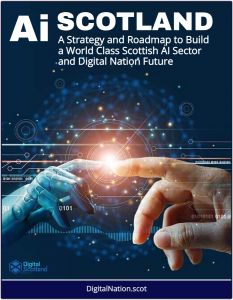Revolutionizing Dementia Care: Scotland’s AI Breakthrough
CENSIS has pioneered an AI-powered device designed to enhance independent living for older and vulnerable individuals.
 A key innovation category within the overall Ai landscape is “Physical AI”, smart software combined with devices and sensors.
A key innovation category within the overall Ai landscape is “Physical AI”, smart software combined with devices and sensors.
CENSIS, Scotland’s national innovation centre for sensing, imaging, and Internet of Things (IoT) technologies based at the University of Glasgow, has pioneered an AI-powered device designed to enhance independent living for older and vulnerable individuals.
The device, developed through the “Peoplehood” project, was unveiled in May 2024 and represents a non-invasive approach to social care by repurposing existing household data, by monitoring daily routines and detecting potential health anomalies, including early signs of dementia.
Development Process
The project began as a collaborative effort involving CENSIS and key partners: the University of Edinburgh, personal data specialist Mydex CIC, care technology firm Carebuilder, and housing provider Blackwood Homes and Care.
Funded by the Scottish Government, it focused on leveraging IoT to address challenges in at-home care for those living alone. Over the course of the initiative, the team built a comprehensive library of “power signatures”—unique electrical patterns generated by common high-energy household appliances like kettles, electric showers, and ovens. These signatures were collected and tagged to map typical usage patterns, such as a person boiling a kettle at 8 a.m. to signal their morning routine.
The core innovation lies in integrating this data with machine learning algorithms. The device connects seamlessly to a smart meter (or even a conventional electric meter) in the home, capturing real-time electrical consumption data without requiring additional sensors or cameras, thus prioritizing privacy.
The AI system then employs pattern recognition to learn an individual’s baseline behaviors over time, identifying deviations that could indicate issues like a fall (a sudden, one-off anomaly) or subtler, gradual changes suggestive of cognitive decline, such as irregular appliance use that might signal forgetfulness or disorientation—early markers of dementia.
How the Device Works
- Data Collection: It passively monitors power fluctuations from the home’s electrical grid, creating a digital “fingerprint” of daily activities.
- AI Analysis: Machine learning models analyze these signatures for irregularities. For instance, if a normally consistent routine (e.g., evening meal preparation) becomes erratic, the system flags it.
- Alerts and Insights: When anomalies are detected, the device sends proactive notifications to carers, family members, or healthcare providers via a secure platform, enabling timely interventions. Over longer periods, aggregated data could track progressive changes, supporting dementia onset detection with further refinement.
- Privacy Focus: Partner Mydex ensures user-controlled data sharing, complying with data protection standards.
This pioneering tool shifts from reactive to preventive care, potentially reducing hospital admissions and empowering independent living. As Stephen Milne, CENSIS’s director of strategic projects, noted, the system “spots erratic behavior” to highlight both immediate risks and longer-term health trends like dementia. Future iterations may expand its capabilities through additional research, making early diagnosis more accessible and efficient.



